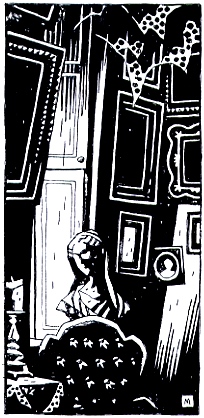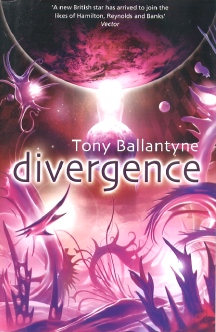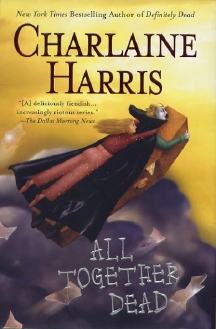|
|
|
|
This Just In...News
From The Agony Column
|
|
05-26-07: Preview for Podcast of Monday, May 28, 2007: "Fail to scale."
Here's an MP3
preview of the Monday May 28, 2007 podcast for The Agony Column. Enjoy!
|
| |
|
05-25-07: Rebecca Stott Takes a 'Ghostwalk'
|
Getting Ahead in 17th Century Cambridge
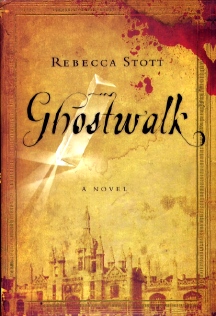 |
|
| Our
blood-spattered past comes back to haunt the bestseller lists. |
So how many books
are born on book tours? I've talked to many an author about book tours
and elicited a wide range of responses with regard
to the tours themselves. Some writers will aver that they came from
working
on a new book to the studio for their interviews, while others confess
they’ve left their computer, notebook, wax tablets and scribes
back at the ranch.
Rebecca Stott may leave the wax tablets behind, but she's clearly
willing to do random research. In 2003, she was touring to support
'Darwin and
the Barnacle'. Presumably, visiting bookstores made it easy for her
to pick up a copy of Patricia Fara's then-new Newton bio, 'The Making
of Genius'.
She was understandably interested in comparing Newton's formative years
to those of Darwin. What she found therein led to no less than her
first novel 'Ghostwalk' (Speigel & Grau / Random House ; May
8, 2007 ; $24.95).
'Ghostwalk' begins when Cameron Vogelsang (no relation to Cartlon Vogelsong
from Jonathan Lethem's 'You
Don’t Love Me Yet') finds his mother,
Elizabeth Vogelsang, dead; drowned in a river, clutching a glass prism.
No rocket science is required to connect her death to her research
for a book on Isaac Newton's involvement with alchemy. He asks Lydia
Brooke
to ghostwrite the final chapters of the books. She will tell the story.
To You.
As You might imagine, the story connects murders in the past, murders
in the present, alchemy and just a soupcon of quantum entanglement,
because,
well, what would we be without quantum entanglement? Separated from
the reading that inspired the novel, to be certain. While on her book
tour,
back in the before-time, Stott discovered some asides in the Newton
bio that referred to his luck in getting a fellowship at Cambridge.
He hadn't
tested well, but lucky guy, don’t you know it, a couple of vacancies
conveniently popped up, and young Isaac suddenly had his shot. Stott
dug deeper and found a diary written in 1667 by an alderman who discussed
the
deaths in a manner that suggested they were suspicious. Four years
later, we've got a shot at reading her novel.
With this sort of subject, Stott faces a peril far more insidious than
centuries-old conspiracies. The far more powerful forces of modern publishing
and Petri-dish culture are going to attempt to take her delightful little
discovery and the literary inventions it spawns market it as a plot-heavy
potboiler. It's so easy and obvious. You throw a little Photoshopped art
on the cover, and voila. You have this summer's historical mystery thriller.
Book geeks should note that the American edition is the first offering
from a new Random House Imprint, Spiegel & Grau. She's joined by Suze
Orman. Well, so they’re one for two. That smiling face is scary.
Dig
deeper, and you'll find a whole host of titles, some of them pretty
damn interesting. There's a novel by Edward Conlon, the author of 'Blue
Blood'. It has a bit of Fortean spin. 'A Season in the Pit' finds Rolling
Stone reporter Matt Taibbi "embedded" in the US Congress,
the Marines in Baghdad and an apocalyptic church in Texas. That's a
whole lot of embedding! No wonder the book won’t be out till
2008.
Book geeks should also note that the actual first edition came from the
UK's respected Weidenfeld & Nicolson. So perhaps you may want to
pick up a copy of the UK version in case the book "pops" on
this side of the pond. If you're that kind of compulsive, which is
not unlikely, given that you're reading this column. Every time I see
Weidenfeld & Nicolson, I think of the first UK hardcover editions of Clive Barker's 'Books
of Blood',
the ones with his patented, garish, wonderful illustrations on the
covers. I'm hurtled back twenty years in time. Heck, the memory is
practically
history.
But Stott is the real deal, an actual historian with an actually good
title to her name. Moreover, her prose is quietly detailed and evocative,
even
though she's writing the novel in an awkward, second person voice,
from Lydia to Cameron. Remember when I mentioned You above? Actually,
as I read
parts of this book I could not help but think of Stanislaw Lem's little
literary satire, a review of a book called "Toi" ("You",
from the French) in 'A Perfect Vacuum'. Funny how one reading can throw
light on another. But Stott is smart enough and good enough that I got
over my Lem-light perception, and found myself immersed in her tale of
science, ambition and murder. There's a bit of a love story here, given
that "Dear Cameron" slant, but not overheated. The whole "real
deal historian" aspect helps keep Stott on target, doling out
details of Newton's life as plot points in a thriller. I can read that.
Stott will
be touring this summer to support this book, and one might well wonder
what she'll discover to propel any future projects.
|
| |
|
05-24-07: Christopher Golden and Mike Mignola Visit 'Baltimore'
|
Collaboration and Conquest
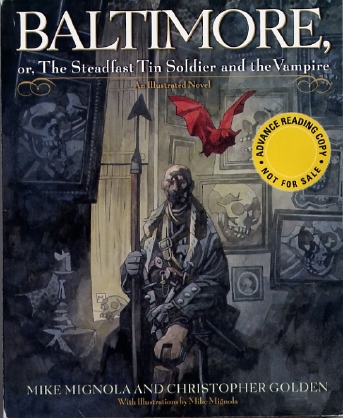 |
|
| One
tin soldier rides away. |
Yes, New York can get
things right once in a while. I'm generally underwhelmed by the products
of our largest publishers. Sure, they can make a book
with decent pages, the covers can be appealing, but it's not often
they put the kind of effort into creating a book that offers more than
mere
words on pages. Night Shade Books, Subterranean Press, Cemetery Dance,
Golden Gryphon and a host of other small publishers put New York
to shame again and again with top--notch productions that offer just a
little
bit more – illustrated novels and short story collections for
adults.
Apparently, editor Anne Groell over at Bantam has been paying attention,
and the result is a big-press publication that will have hardcover
collector types drooling even if they do produce a bazillion copies.
'Baltimore,
or The Steadfast Tin Soldier and the Vampire' (Bantam Dell / Random
House ; August 28, 2007 ; $25) by Christopher Golden and Mike Mignola
is the
sort of fantastic title you’d expect from the small press. It's
a richly illustrated adventurously written novel of genre fiction that
pushes
boundaries as well as buttons. It absolutely rocks, and gives Golden
a chance to shine sitting right beside a name with big-screen movie
recognition.
The story is happily quite complicated. Lord Henry Baltimore finds himself
laying amongst the dead on a World War I battlefield, and espies something
feeding on them that is neither animal nor human. Thus begins a hunt for
an amorphous, hideous evil that will take him around the world. Illustrated
by Mike Mignola, it will take readers of genre fiction to several kinds
of heaven.
|
|
Stark
images free the imagination.
|
Let me make this clear; Golden's writing has never been better, and he's
a first-class writer in any event. But here, he pushes himself into a sort
of fever dream, with a rich, heady prose that will evoke images in the
reader's mind .... as dark as ... as powerful as ... Mignola's illustrations.
Illustrated novels can be a dicey business. Too much detail and you're
limiting the reader's imagination. Too little detail and you're just taking
up space, Mignola hits the perfect middle ground, offering a series of
over 150 woodcut-style illustrations that compliment Golden's prose without
trapping it. As a reader you will feel your imagination fly more freely
than you may have reasonably expected possible. The story is labyrinthine
and bizarre, verging on experiment. The combination of story and image
is rich and satisfying.
A huge part of the reading experience of this sort of novel stems from
the production values. Great stories and excellent illustrations, no
matter how well-told, no matter how plentiful, can't fly from the pages
if the
pages are badly printed or cheaply produced. And since what I have
is an advance reading copy, I could be wrong. But the ARC production
values are
spot-on. The book is larger than usual, 8 1/2" by 9 1/4".
The pages are very white, the ink is very dark. Nothing is sacrificed
for the
sake of cutting a costly corner. Now, it's not as if this is particularly
difficult. The small presses I mention above -- and others I've left
out for the sake of space -- have all been doing this for years. Even
big-press
Bloomsbury gave us Susanna Clarke's 'Jonathan
Strange and Mr Norrell' with
illustrations; and there are other examples out there as well. These books
are easily produced. But they are not common.
|
| |
|
05-23-07: A Review of 'The Big Girls' by Susanna Moore
|
A Woman's Rant
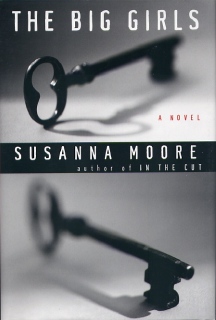 |
|
| Chip
Kidd captures the essence of Moore's novel. |
I'm not sure how long it will take me to recover from reading 'The
Big Girls', Susanne Moore's powerful vision of how friggin' horrible we are.
But in the interim, I can at least step back and disconnect at the level
of technique to enjoy the work. Moore's novel, like Chuck Palahniuk's
'Rant', uses the technique of a fictional oral history to plumb the depths
even more effectively than Palahniuk. 'The Big Girls' is a woman's 'Rant'.
Readers of Palahniuk's latest novel, those who enjoy the discomfiting aspects,
the makes-you-squirm effect, will have a hell of a bad-good time cringing
through 'The Big Girls'. Moore's novel is considerably leaner than Palahniuk's,
but the storytelling effect is precisely the same. This is a not a novel
that tells you what to think with a godly perspective. The reader is the
god of this novel, and trust me, the world you shall inherit is not a happy
one.
Of course that much is obvious from the setup; a woman psychiatrist at
prison hospital is treating a notorious mother who killed her children.
How much worse can it get? Plenty. But what makes 'The Big Girls' a fascinating
reading experience is Moore's ability, her willingness to let the reader
tell the story. Moore's work is largely reportorial, almost like a series
of newspaper or diary clippings. Almost. Except for the incredible skill
with which everything is assembled into a single-sitting reading experience.
Unless of course, you're not strong enough to take it. Many readers should
not read this book. But if you enjoyed 'Rant', you should enjoy 'The Big
Girls'. Or seek therapy. Or both.
|
| |
|
05-22-07: Tony Ballantyne Achieves 'Divergence'
|
Saint Augustine and Science Fiction
|
|
Psychedelic,
man? Can you dig the Saint Augustine vibe?
|
Saint Augustine is a
not an influence one expects to find in the world of science fiction. The
fourth century philosopher is mostly known
these days for such gems as "Love the sinner and hate the sin".
But his thoughts on predestination and the nature of time have lots
of resonance
in the world of science fiction. Those who are familiar with Saint
Augustine's work will get a real kick out of Tony Ballantyne's "The
Watcher" trilogy,
which he began in 'Recursion',
continued in 'Capacity' and now concludes in 'Divergence' ( Tor UK
/ Pan MacMillan ; May 4, 2007 ; £10.99
; Bantam Spectra / Random House ; May 1, 2007 ; $6.99). This tightly-woven
series offers a combination of philosophical conundrums played out
using science fiction tropes. Ballantyne writes gripping science
fiction in
which the answers to the biggest questions have immediate consequences
for the characters who inhabit his cleverly conceived futures. I
talked to Ballantyne shortly after 'Recursion' came out; he's
a fascinating guy, and I highly recommend you take a look at his
website for lots
of arcana behind the books. (And not Augustinian.)
Ballantyne's series is very much a series, so do not plan on reading
them out of order or as standalone novels. You'll definitely miss
plot points,
especially since characters who show up in numbered chapters in 'Recursion'
do not return until subsequently numbered chapters in 'Divergence'.
Moreover, Ballantyne writes in a rather opaque style that I would
term "science
fiction mystery", but NOT in the sense of crime fiction mysteries.
Instead, the mysteries in these novels involve the very nature of the world
Ballantyne is describing and what the precise relationship is between the
characters. Often, they don't at first seem to even be in the same novel,
though that is much less true in 'Divergence'. But Ballantyne operates
in his own manner and does eventually reveal how and why everything in
his novels is connected. Putting together the "mystery" of
how everything in the novel connects is one of the main delights in
reading
these novels.
'Divergence' offers a pretty straightforward setup. Passengers in a
spaceship decide to engage in interstellar trade with a robot– or is it a spaceship? – they
encounter. To do so, they engage FE (Fair Exchange) software that guarantees
everyone comes out ahead. But it sure doesn't feel that way to the
passengers, who soon enough find themselves encumbered with Judy, from
'Capacity',
who works in Social Care. She's in the employ of The Watcher, the AI
that makes sure humanity is happy if not exactly free, and the passengers
of
the starship Eva Rye will be bringing her back to Earth.
'Divergence' is fast-paced and exciting to read, even as the philosophical
concerns play out in the plotting. The character's dialogues are practically
Socratic at times, discussing free will and predestination in terms
of virtual and real world computer programming. Open your mind to both
ends
of the spectrum – the science fiction tropes of virtual reality,
Artificial Intelligence and Von Neumann Machines, and the philosophical
ideas of free will, capitalism, and human nature – and you’re
in for a real treat. Spaceships are rebuilt and reborn, copied and
upgraded while reality takes a holiday. Capitalism is viewed as a computer
virus,
or a genetic flaw in human DNA. Or is it a strength? This is one of
the key questions resolved most satisfyingly by Ballantyne in 'Divergence'.
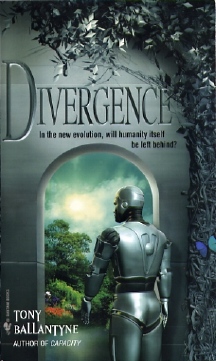 |
|
| A
lusher view of the world from the US publisher. |
Don’t let the
space opera comparisons fool you. 'Recursion', 'Capacity' and 'Divergence'
do include some space travel and a very
nice Menace from
Beyond the Stars that could reasonably draw comparison to Alastair
Reynolds. But space travel is pretty perfunctory in these novels. It's
hyper-drive
hand-waving so that the characters can play out their drawing room
dramas in a moving vehicle. The thrust in 'Divergence ' is mostly on
an ethereal
level, and it is a total delight. Ballantyne has a very tight, stripped-down
writing style. But that just gives his ideas more room to resonate
and expand.
One further comment that is relevant only to paper-book loving fetishists – in
either set, these books are outstandingly well-designed. I prefer the
UK trade paperbacks, just because the print inside ends up bigger,
and there's
a spacious feeling in the page layouts. Dominic Harman's cover art
for all three books is classic, 1970's-style SF art, updated for a
new, though
less-shiny century. I like the set enough that I've been hauling the
three of them around since they arrived. The US mass-market paperbacks
take a
different, though no-less effective tack. The art, by John Blackford,
is lush and hyper-real. The layout and design, by Jamie S. Warren Youll
is
classy. Either way, the books themselves are a fine compliment to the
excellent writing within.
|
| |
|
05-21-07: A 2007 Interview with Charlaine Harris
|
"Let's give 'em
vampires"
|
|
Pay
close attention to the action illustrated on the cover.
|
Charlaine Harris is
a happy writer. Her new book, 'All Together Dead' is a bestseller. Her
Sookie Stackhouse series is being adapted for HBO
by Alan Ball. And all this stems from a book she told me that her agent
didn't like, that took her two years to sell. This when she had two or
three cozy mystery series in progress. I could understand why she told
me, "I'm feeling pretty neener neener neener about that now."
What I didn't expect her to tell me was the agenda behind this popular
vampire series, which I'll leave for you to discover in the interview
I'm podcasting today. You can download the MP3
from this link or the
RealAudio from this link. Harris is a very funny writer who works her
humor in a deadpan manner, which is my favorite delivery method. But
she's not above slapstick comedy, as you'll note when you read 'All Together
Dead', where you'll find the most unlikely combination of humor and terror
I've read recently. But more than being funny in print, she's funny in
person.
You'll also find Harris introducing two new critters from her supernatural
pantheon, two Conanette barbarian babes whom she describes as, "a
tip of the hat to my desire to write books about women with big whacking
swords who kill people, because they were just a lot of fun to writer,
they've got armor, they've got swords, they've got guns, they’ve
got everything." She mentions that she'd like to write a novella
about them.
Harris also talked about her involvement with her fans on her website
charlaineharris.com. She listens to her fans, and they actually contribute
to her books, so write her and tell her to do that novella. In the interim,
you can hope that HBO gets True Blood in gear and ready for
next fall. It sounds as if they’re adapting the books quite literally.
Literal adaptations. It's enough to make your blood run cold.
|
| |
|
|




